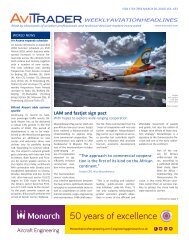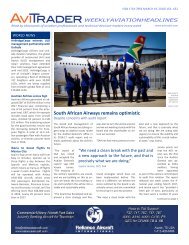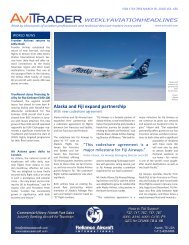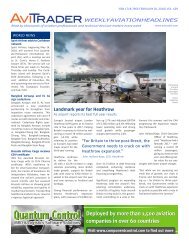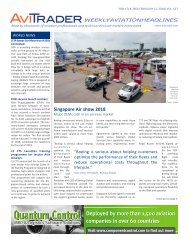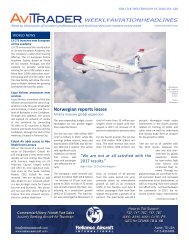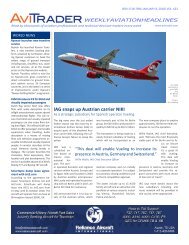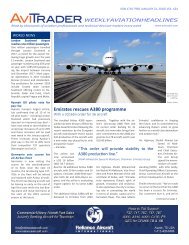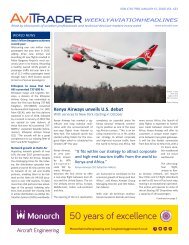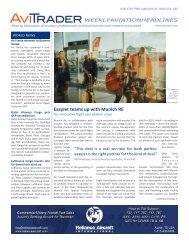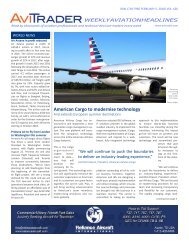AviTrader_Monthly_MRO_e-Magazine_2013-12
AviTrader_Monthly_MRO_e-Magazine_2013-12
AviTrader_Monthly_MRO_e-Magazine_2013-12
You also want an ePaper? Increase the reach of your titles
YUMPU automatically turns print PDFs into web optimized ePapers that Google loves.
The 737 aftermarket<br />
28<br />
The 737 aftermarket: will the gamble pay off?<br />
“While some have been worrying about the<br />
shrinking aircraft retirement age, Boeing has<br />
repeatedly stated that the 737MAX will be designed<br />
so that it could<br />
be supported by the existing<br />
industry-wide 737<br />
maintenance infrastructure.<br />
For example, the<br />
manufacturer’s representatives<br />
have made it<br />
clear that the new model<br />
will not require special<br />
certification for the <strong>MRO</strong><br />
providers,” says the CEO<br />
of Locatory.com “This<br />
means that the 737NGs<br />
and 737MAXs are bound<br />
to have a quite high level<br />
of spare parts commonality,<br />
which will automatically<br />
straighten out<br />
the situation in the aftermarket.”<br />
A worry over shrinking aircraft retirement age.<br />
Currently the number of orders for all Boeing 737<br />
versions has passed 11000. As the manufacturer<br />
is planning to introduce its 737MAX into service<br />
in 2017, this figure is likely to grow considerably.<br />
With the record breaking production rates pushing<br />
the current generation of these aircraft into<br />
premature retirement, more and more aftermarket<br />
players are forced to recognize the negative<br />
implications of the increasing availability of the<br />
used spare parts. However, it seems that the possible<br />
design similarities between the current and<br />
the upcoming aircraft models may turn the potential<br />
disaster into a jackpot.<br />
The in-service fleet of Boeing 737s is currently<br />
the largest among airliners, accounting for close<br />
to 6000 aircraft. With a record number of almost<br />
3500 B737s waiting to be delivered, the<br />
popularity of the model is certainly expected to<br />
remain stable. Moreover, the manufacturer has<br />
announced that it will increase the production<br />
of the model from the current 38 to 47 aircraft<br />
in 2017 and as many as 52 aircraft per month in<br />
2019. In other words, the company is expecting<br />
a more than 50% increase in aircraft production<br />
in less than 10 years. However, currently the<br />
growing numbers of aftermarket players have<br />
started to worry about the effects that this process<br />
will have on the spare part business.<br />
“The pressure that the growing aircraft production<br />
rates are exerting on the aftermarket is increasingly<br />
becoming the central topic of discussion<br />
amongst aviation industry players. Basically,<br />
the problem is that what is normally best for an<br />
aircraft manufacturer is not necessarily good<br />
news for a spare parts provider,” explains Zilvinas<br />
Sadauskas, the CEO of Locatory.com “Naturally,<br />
increasing production rates help to reduce unit<br />
cost and thus are totally financially justified, especially<br />
since aircraft OEMs do not make much money<br />
from the aftermarket. However, an increased<br />
availability of newer aircraft means faster retirement<br />
rates. As a result, the aftermarket becomes<br />
filled with spare parts, some of which are low in<br />
demand whilst some have partly lost their value.”<br />
Statistically, the retirement rates of the current<br />
generation B737 aircraft are in fact impressive.<br />
According to the recent AWIN report, currently<br />
almost 40 737NGs at an average age of <strong>12</strong> years<br />
have already been forced into a premature retirement<br />
with an objective to benefit from the<br />
spare parts sales. However, the existing demand<br />
might have been overestimated, since the current<br />
models are not as old and do not need as<br />
much technical attention. Nevertheless, it seems<br />
that the manufacturers which have started the<br />
mess might also be the ones to provide the solution<br />
to the problem.<br />
Certainly, despite the<br />
fact that the introduction<br />
of the newest member<br />
of the 737 family is on<br />
schedule, 2017 is relatively<br />
far away, and the<br />
Photo: Boeing<br />
decisions made during<br />
the aircraft design phase can and will bring some<br />
new aspects into consideration. However, if a<br />
significant amount of parts will migrate from the<br />
NG to its younger brother, the ones who are now<br />
blamed for causing the deflation in the spares<br />
market do share a chance to end up benefiting<br />
from the situation, as the value of stocked spares<br />
will rise along with the demand.<br />
Source: Avia Solutions Group<br />
Zilvinas Sadauskas CEO of Locatory<br />
<strong>AviTrader</strong> <strong>MRO</strong> - Dezember <strong>2013</strong>





